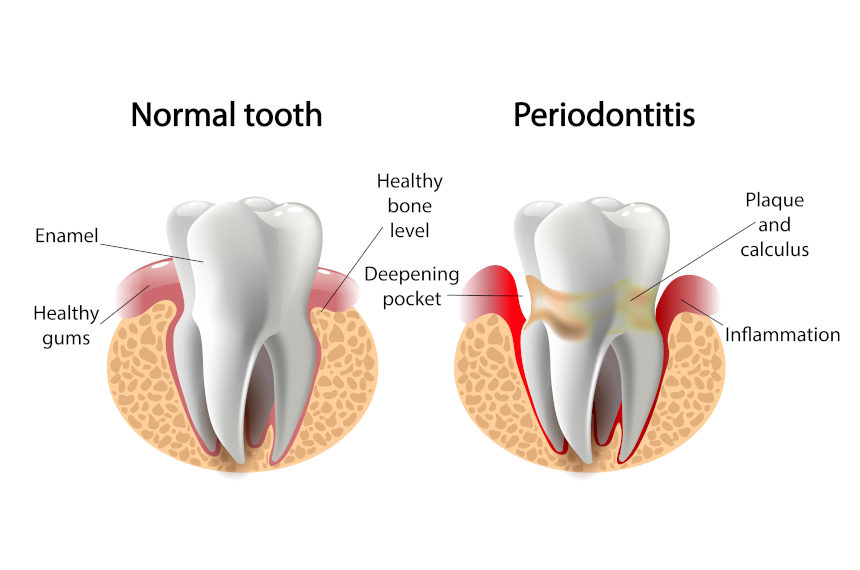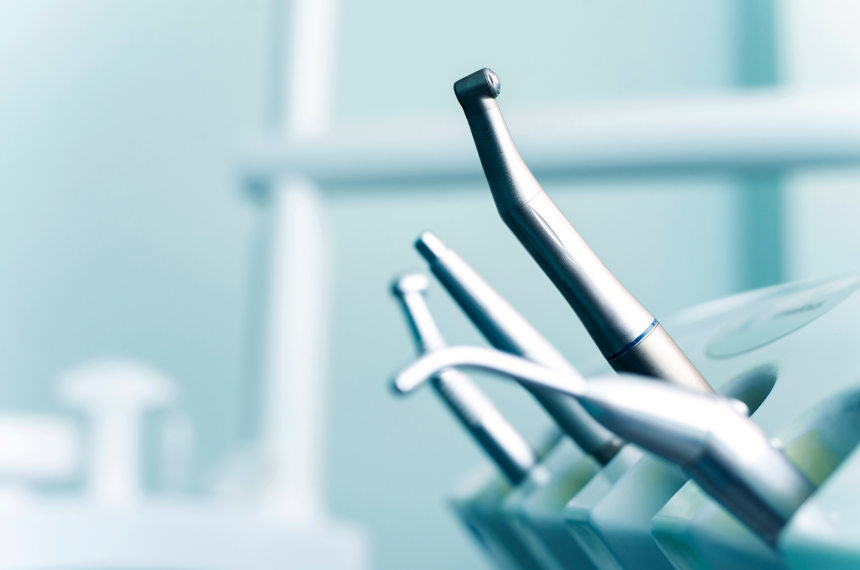TYPES OF DISEASES
Periodontal diseases as the term perio(around) + dontal(tooth) implies, are inflammatory diseases of microbial cause that affect what is peripheral to the tooth ie the gums and bone supporting the tooth. Oral germs that tend to adhere to tooth surfaces are the common causative factor. So in those areas where brushing is inadequate, germs have devastating effects on the gum and bone. The most common types of diseases are:
A. Gingivitis (gum disease)
Gingivitis is an inflammation that affects the gums and not the bone. It is accompanied by bleeding, edema and redness of the gums. The tooth is not at risk of being lost, but if the disease is left untreated it can progress to periodontal disease and tooth loss.Gingivitis treatment
The treatment of gingivitis consists of removing the tartar from the surface of the teeth (scaling) and oral hygiene instructions. The disease is completely reversible.B. Periodontal disease
Periodontitis is currently the major cause of tooth loss. A large proportion of the population suffers from mild periodontitis, while another 10-15% suffers from severe periodontitis, which ultimately results in bone and tooth loss. Periodontitis is the progression of untreated gingivitis and affects the bone that supports the tooth. The gums begin to detach from the tooth, creating areas called pockets and the tooth gradually becomes loose and eventually is lost. There are two types: aggressive and chronic periodontitis. Chronic periodontitis usually occurs in adults, but can be also seen at younger ages. It is characterized by slow destruction of the supporting bone, as opposed to the aggressive form in which the progress of destruction is greater.Treatment of Periodontitis
The treatment of Periodontitis helps to control bone damage. It always starts with the most conservative method (non-surgical treatment) and proceeds with more invasive methods (surgical treatment), depending on the severity of the disease. In the conservative phase of treatment, tartar and microbial deposits are removed from the root surface (root planning), using local anesthesia and ultrasound devices. In most surfaces of the teeth the treatment is successful and patients do not need further treatment. In those areas where the disease has not been resolved with the conservative method, we proceed in the surgical phase.C. Necrotizing Ulcerative Gingivitis
A type of gingivitis that is characterized by destruction of the gums between the teeth and severe pain, apart from the symptoms of simple gingivitis. Smoking and stress are risk factors.Treatment of ulcerative gingivitis
Treatment focuses on the removal of microbial deposits and calculus from the teeth surfaces using ultrasound devices, and on the use of antimicrobial mouthwashes. Almost always, additional antibiotic therapy is needed to completely eradicate the disease and relieve the patient.D. Periimplantitis
Periimplantitis, like Periodontitis, is an inflammatory disease that affects the bone around the implant. It is caused by the accumulation of microbes on the implant, which leads to the gradual detachment of the gums and the appearance of pockets. Patients with a history of Periodontitis are more likely to be infected with Periimplantitis. For this reason, Periodontitis must be treated before dental implants are placed in the patient's mouth.Treatment of Periimplantitis
The treatment of Periimplantitis is similar to the treatment of Periodontitis. It begins with conservative (non-surgical) treatment and proceeds with more invasive methods that aim to stop the permanent destruction of the bone. Usually the most effective treatment in Periimplantitis are the surgical methods, which with the help of grafts, aim to regenerate the lost bone around the implant.Supportive Periodontal Treatment
Gingivitis, Periodontitis and Periimplantitis are diseases that can easily recur easily after treatment, especially when oral hygiene is inadequate. This recurrence is not always perceived by the patient to seek help. For this reason, all patients are required to visit a periodontal recall every 4 - 6 months after the end of their treatment to immediately address any problems and thus maintain gum health.PLASTIC PERIODONTAL SURGERY
When we talk about periodontal plastic surgery we mean all the operations on the tissues around the teeth, ie the gums and mucosa, which aim to improve the aesthetic and functionality of the tooth.Gummy smile
The appearance of a wider band of gums than normal when smiling is called a gummy smile and often creates an aesthetic problem that affects the patient psychologically. The Periodontist can, with relatively simple and painless surgery, rectify this problem and give the patient the aesthetics that will make him / her comfortable.
Root coverage procedures
Gum recession and the exposure of a part of the root surface is not only a cosmetic problem, but also sometimes a functional one, since the exposed areas are in pain when in contact with the cold. It is usually due to the use of a hard toothbrush or tooth brushing with excessive pressure. The coverage of the root is performed by the use of gingival grafts taken from patient's palate or by synthetic grafts
Crown lengthening procedure
Procedure aimed at increasing the height of the tooth crown either for aesthetic reasons (see gummy smile) or for the purpose of tooth restoration. It is considered necessary procedure when e.g. the decay in a tooth has expanded beneath the gums and the dentist cannot achieve its total removal or when the tooth crown is short and the hold of a cup is impossible.
Frenectomy
Frenum removal is indicated in cases where, due to its size, causes problems in the oral hygiene of the area or interferes with the completion of an orthodontic treatment, in particular the closure of the upper central areas.
Gingivectomy
Surgical procedure applied in cases where we have enlarged gums (gingival hyperplasia) due to inflammation or use of medication (antihypertensive etc.).
Visit Periodontologist Nikolaos Delendas,
for specialized high-quality dental services.
for specialized high-quality dental services.







